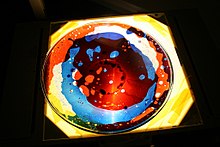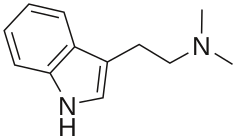
Back Psychedelisch ALS سايكدلية Arabic سايكدلية ARY Psixodeliya Azerbaijani Психеделия Bulgarian সাইকেডেলিয়া Bengali/Bangla Psicodèlia Catalan Psychedelie Czech Psykedelisk Danish Psychedelisch German
This article needs additional citations for verification. (July 2016) |


| Part of a series on |
| Psychedelia |
|---|
 |
Psychedelia usually refers to a style or aesthetic that is resembled in the psychedelic subculture of the 1960s and the psychedelic experience produced by certain psychoactive substances. This includes psychedelic art, psychedelic music and style of dress during that era. This was primarily generated by people who used psychedelic drugs such as LSD, mescaline (found in peyote) and psilocybin (found in magic mushrooms) and also non-users who were participants and aficionados of this subculture. Psychedelic art and music typically recreate or reflect the experience of altered consciousness. Psychedelic art uses highly distorted, surreal visuals, bright colors and full spectrums and animation (including cartoons) to evoke, convey, or enhance the psychedelic experience.
Psychedelic music uses distorted electric guitar, Indian music elements such as the sitar, tabla,[1] electronic effects, sound effects and reverb, and elaborate studio effects, such as playing tapes backwards or panning the music from one side to another.[2]
A psychedelic experience is characterized by the striking perception of aspects of one's mind previously unknown, or by the creative exuberance of the mind liberated from its ostensibly ordinary fetters. Psychedelic states are an array of experiences including changes of perception such as hallucinations, synesthesia, altered states of awareness or focused consciousness, variation in thought patterns, trance or hypnotic states, mystical states, and other mind alterations.[3]
These processes can lead some people to experience changes in mental operation defining their self-identity (whether in momentary acuity or chronic development) different enough from their previous normal state that it can excite feelings of newly formed understanding such as revelation, illumination, confusion, and psychosis. Individuals who use psychedelic drugs for spiritual purposes or self-discovery are commonly referred to as psychonauts.
- ^ Rubin, Rachel, 1964– (2007). Immigration and American popular culture : an introduction. Melnick, Jeffrey Paul. New York: New York University Press. ISBN 978-1-4356-0043-0. OCLC 173511775.
{{cite book}}: CS1 maint: multiple names: authors list (link) CS1 maint: numeric names: authors list (link) - ^ Hicks, Michael, 1956– (1999). Sixties rock : garage, psychedelic, and other satisfactions. Urbana: University of Illinois Press. ISBN 0-252-02427-3. OCLC 38504347.
{{cite book}}: CS1 maint: multiple names: authors list (link) CS1 maint: numeric names: authors list (link) - ^ "What is a "Psychedelic Experience?" | Mindbloom". www.mindbloom.com. Retrieved 2024-09-03.